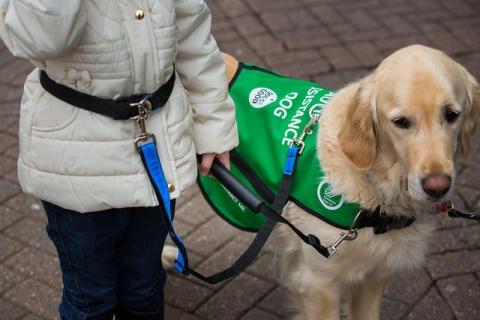
Published on November 14 by Julia
Autism Spectrum Disorder (ASD) affects individuals in a variety of ways, but common challenges include difficulty with social interactions, sensory sensitivities, and emotional regulation. For many individuals on the autism spectrum, therapy dogs have become invaluable companions, providing emotional support, enhancing social skills, and offering comfort in challenging situations.
An autism therapy dog is a specially trained canine that works alongside individuals with autism to provide assistance, comfort, and companionship. These dogs are not only service animals that help with physical tasks; they also play a crucial role in supporting emotional well-being. Unlike regular pets, autism therapy dogs are trained to recognize and respond to specific needs, such as calming a person who is overwhelmed by sensory stimuli or offering comfort during social interactions.
One of the primary benefits of an autism therapy dog is their ability to provide emotional support. Many individuals with autism experience heightened anxiety, sensory overload, or meltdowns in social situations. A therapy dog can offer a calming presence by providing physical comfort, such as laying next to the person, offering pawing or nuzzling, or simply being there as a source of unconditional companionship. The act of petting or cuddling with a dog can reduce cortisol (the stress hormone) and increase oxytocin, which is known as the "feel-good" hormone.
For children and adults with autism, social interactions can be challenging. Therapy dogs can act as social bridges, helping individuals engage with others in a non-threatening, non-judgmental way. A child with autism may be more likely to interact with peers or adults when there is a dog present. Therapy dogs can also help initiate conversations, with children often feeling more comfortable talking about their dog than themselves, which can lead to improved social engagement over time.

Individuals with autism often have sensory sensitivities, meaning they may be over or under-sensitive to sounds, textures, lights, or smells. Therapy dogs can help regulate these sensitivities by providing grounding sensory input. For example, petting a dog can serve as a soothing tactile sensation, helping to redirect focus from overwhelming stimuli. The rhythmic nature of a dog’s breathing or the weight of the dog lying close by can also provide sensory feedback that promotes calm.
For some individuals with autism, wandering or becoming disoriented in unfamiliar environments can be a concern. Trained therapy dogs can provide physical guidance, and in some cases, may be trained to lead their owner back to safety or alert others if the person is in distress. The bond between the dog and the individual can also provide a sense of security, helping the person feel more confident when navigating the world.
Dogs thrive on routine, and this can be beneficial for individuals with autism who often feel more comfortable with predictable, structured schedules. Having a therapy dog requires certain responsibilities, such as feeding, walking, and caring for the dog. This can help an individual with autism build routine and structure in their daily life, which can be reassuring and provide a sense of purpose.
Training an autism therapy dog is a comprehensive process that requires both specialized training for the dog and tailored support for the individual with autism. Therapy dogs are typically selected for their calm demeanor, social behavior, and ability to stay focused in various situations. They are trained to respond to specific cues and situations, such as:
Many autism therapy dogs undergo professional training with organizations that specialize in service dogs, such as Service Dogs for America, Dogs for Good, or 4 Paws for Ability. This training can take anywhere from six months to two years, depending on the needs of the individual and the complexity of the tasks required.

There are numerous accounts of individuals with autism experiencing life-changing transformations with the help of therapy dogs. For instance, a young boy named Ethan, diagnosed with autism, was unable to engage with peers and often became overwhelmed in public spaces. After receiving a therapy dog named Max, Ethan’s mother reported seeing dramatic improvements in his social behavior. Ethan began to make eye contact with people, interact with others more frequently, and show reduced anxiety during outings.
Similarly, a teenage girl with autism named Lily had significant struggles with emotional regulation and social communication. After being paired with a therapy dog named Daisy, Lily became more comfortable in social settings and was able to manage her stress and anxiety better. Daisy provided Lily with both emotional comfort and a sense of security, which allowed her to participate in activities she had once avoided.
While autism therapy dogs provide a wide range of benefits, there are also considerations to take into account before getting a therapy dog:
Autism therapy dogs offer a remarkable way to support individuals on the autism spectrum, helping them navigate the challenges of daily life with increased confidence, emotional regulation, and social connection. These specially trained dogs provide not only physical support but also serve as emotional anchors, making a profound difference in the lives of both children and adults with autism. With the right training, resources, and commitment, therapy dogs can enhance quality of life, providing individuals with autism a greater sense of security, comfort, and independence.
Discover More Content





